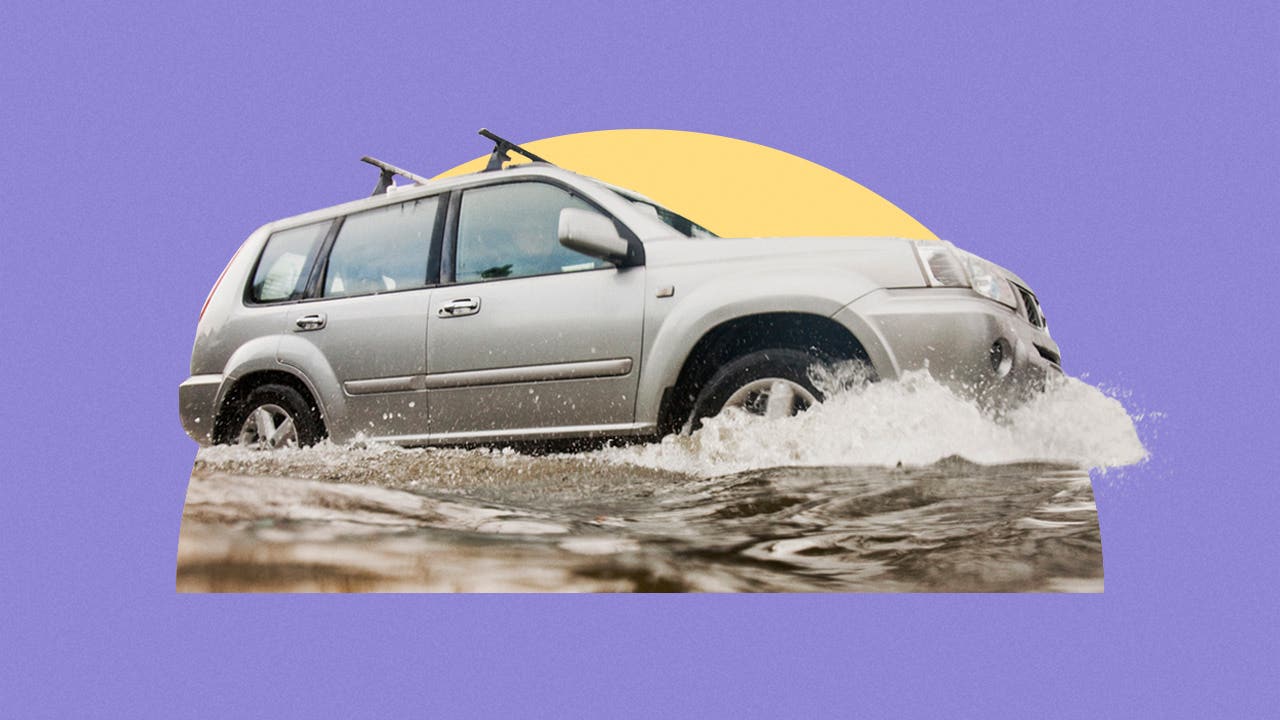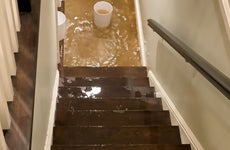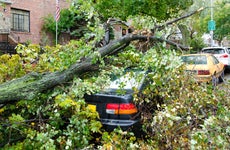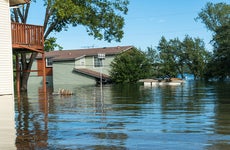Does car insurance cover flooding damage?

The Bankrate promise
At Bankrate, we strive to help you make smarter financial decisions. To help readers understand how insurance affects their finances, we have licensed insurance professionals on staff who have spent a combined 47 years in the auto, home and life insurance industries. While we adhere to strict , this post may contain references to products from our partners. Here's an explanation of . Our content is backed by Coverage.com, LLC, a licensed entity (NPN: 19966249). For more information, please see our .
Our writers and editors used an in-house natural language generation platform to assist with portions of this article, allowing them to focus on adding information that is uniquely helpful. The article was reviewed, fact-checked and edited by our editorial staff prior to publication.
Flooding occurs more than any other natural disaster in the U.S. and landfalling hurricanes and tropical storms often come with torrential rainfall and storm surge that can cause significant street flooding. While damage to homes from floods can be extensive and extremely costly, so can other types of flood-related damage. Water damage to vehicles is relatively common during floods and can cause extensive internal and external damage. More than 100,000 vehicles were damaged by flooding in Florida during Hurricane Ian in 2022, according to the Insurance Information Institute (Triple-I). The good news is that certain types of car insurance may cover flood damage. Bankrate’s insurance editorial team explains.
Does insurance cover a flooded car?
Flood waters can cause mechanical issues, electrical damage, rust and mold spores in vehicles. Salt water intrusion to the engine of an electric vehicle can even cause the car to catch fire. Flooding may also leave a layer of moisture or residue in your car, which can result in major issues or losses. To protect yourself financially in the event a flood damages your vehicle, you will need to have comprehensive coverage. Comprehensive insurance and collision insurance are typically sold together as part of a full coverage car insurance policy. About 80 percent of U.S. drivers carry these coverage types, according to the Triple-I.
Comprehensive coverage offers broad financial protection for most vehicle damage or losses caused by factors other than a collision. In addition to flood damage, comprehensive insurance can help pay for repairs or replacement costs if your car is stolen, vandalized or damaged by an animal, fire, hail or falling objects. Collision coverage, on the other hand, is designed to protect you from financial loss resulting from vehicle damage caused by colliding with another vehicle or a stationary object, such as a tree, fence or light pole. Collision also covers rollover accidents and pothole damage.
While almost all states require drivers to carry a minimum amount of car insurance, full coverage is not required by law. Typically, liability insurance is mandatory and comprehensive and collision coverage are both optional. However, if a vehicle is financed, your lender or lessor may require you to carry full coverage until you have paid off the car since liability-only insurance will not cover damage to your vehicle.
Does comprehensive insurance have a deductible for flood damage?
When you file a comprehensive claim, you will be responsible for paying for the cost of your deductible toward the cost of the repairs. The deductible is the amount of money the policyholder is responsible for. If the deductible is $500, for example, the insurance company will provide financial assistance for flood repairs on the vehicle, but the payout will be reduced by $500.
When does car insurance not cover flood damage?
Many people attempt to save money by purchasing the minimum limits of insurance required by state law. Unfortunately, because these requirements mainly involve liability insurance, solely carrying this type of coverage is unlikely to provide coverage for flood damage to your vehicle.
What other types of car insurance can help if your car is destroyed in a flood?
If your car is insured with comprehensive coverage, any flood-induced damage should be covered in most cases (up to your policy limits). If your claim is approved, you may be able to get your vehicle repairs covered, or your insurer will compensate you for the current value of the car if it is totaled, which is quite common following flood damage.
These are some other types of insurance that may come in handy if your car is damaged or destroyed in a flood.
How does gap insurance help in case of flood damage?
If you’re financing your car, gap insurance could potentially help you in case of flood damage. If your car’s current value is less than what you owe to your lender, you may be held liable for the difference. Gap coverage could help pay off the loan if your vehicle is declared totaled after a flood. If the claim is approved, it would pay the difference between the actual value of the car and the amount owed on it, excluding the deductible.
How does rental car reimbursement coverage help after flood damage?
Rental car reimbursement coverage, which is often offered as an endorsement to your car insurance policy, helps pay for rental car costs when your vehicle is in the shop for repairs. In cases of severe weather, damage may be widespread within a community. That means many cars may need repairs, and it may take longer than usual for your vehicle to be serviced. Having this coverage may be beneficial if you need transportation in the interim. Keep in mind that, like with any insurance, rental car reimbursement has limits; in this case, both in how much you can spend on the rental and how long the insurance company will help cover your rental.
What happens if your car is destroyed in a flood?
If you do not have the appropriate car insurance, flood damage can result in costly repairs or a complete loss of the vehicle. Floods can damage electrical components, fluids, mechanical systems and safety mechanisms like airbags. Comprehensive auto insurance provides valuable financial coverage for repairs due to flood damage or compensation for the vehicle’s total loss.
Some insurance companies will attempt to work out a repair solution before declaring the vehicle totaled. However, it is important to understand the many other problems flooding can cause in cars that may not appear initially. Insurance experts usually recommend speaking with your carrier about how this type of damage will be handled should it occur down the line.
How hard is it to repair a flood-damaged car?
It is very difficult to repair a vehicle that has been damaged by severe flooding. After a car has water damage, it’s common to have issues with mold, corrosion and even damage to the electrical systems, which can get worse over time. If an adjuster says your car is repairable, the best way to go about it may be to ensure that the repair shop you choose has experience with this type of damage. Also, you may want to make it clear that the damage is due to water before repairs begin.
How do I file a car insurance claim after a flood?
As with any claim, it is important to notify your car insurer as soon as you become aware of flood damage. You don’t need to have all the details gathered or even understand the extent of damage to provide this initial notice. You can begin a claim by calling your insurance representative or, in many cases, by going online or using a mobile app. You will be given a claim number and assigned a claims adjuster.
As soon as possible, document the vehicle damage per your insurer’s guidance. This could include taking photos and videos and providing a timeline of the flooding that caused the damage. Submit this material to your auto insurer as it is gathered.
At some point, an adjuster might be sent to assess the damage to the vehicle in person. Based on this appraisal and your input, your insurer will likely make you an offer. It is always wise to obtain your own assessment of the damage and cost of repairs from your own automobile mechanic at that point. Remember that you are under no obligation to accept the first insurance offer, and you can make a counterproposal based on your own assessment.
How can you protect your car from flood damage?
Sadly, once a flood strikes, there’s very little you can do to protect your car from the damage. However, you can take numerous steps to keep your vehicle safe from flood damage in the future. The following tips may help you prepare for the worst.
- Invest in a protective enclosure: Flood-proof enclosures are plastic wraps mounted on garages to keep cars safe from external flood-related damage. Although these protective enclosures are sometimes costly, they can potentially minimize damage and save you money.
- Avoid driving through flooded areas: Although it can be tempting to drive through a shallow amount of still water, it should be avoided whenever possible. Instead, consider taking an alternative route. This keeps your automobile from being exposed to water, which may lead to severe damage.
- Move your car to higher ground: If severe weather is in the forecast, it could be best to move your car to higher ground when not in use. This can help minimize damage in the event of a flash flood, hurricane or other event.
- Dry floodproof your home or garage: Flooding can have a long-lasting impact on many kinds of property. Dry floodproofing involves the application of protective measures (for example, a layer of brick sealed with a waterproof veneer) to prevent water from entering structures like homes and garages. This can be done during the construction process or even later by adding protective measures when water starts to creep in through the walls.
Frequently asked questions
-
-
Because insurance companies also realize the difficulties in repairing flooded vehicles, they may be more inclined to declare a flooded car totaled. This is particularly true if the vehicle was exposed to water that rose several inches or more and remained in the car for a substantial amount of time. It may be beneficial to raise this issue with your insurer and stress that some flooding damage could appear later.
-
It may be worth repairing a flooded car in some cases, but it likely won’t be worth repairing a car that has extensive flood damage. The first step in determining whether it’s a good idea to repair a flooded car is to understand the extent of the damage. If the water has damaged critical parts of the car, it may not be a good idea to try and repair the vehicle. For example, if you drive through high floodwaters and the water seeps into an engine through the vehicle air intake, the engine can hydrolock, which will likely ruin the engine beyond repair. The only way to determine if your car is worth repairing is to work with a trusted mechanic who can assess the damage.
-
Cars can be damaged by flooding for several reasons, and the damage may not be visible to the eye. However, if you suspect a car may have been affected by water damage, it is recommended to have a professional mechanic inspect it. The National Insurance Crime Bureau (NICB) recommends that you look for water stains, mildew, sand, silt and smells, such as the aroma of heavy cleaners that may have been used to try to cover up the damage. Check the engine oil for abnormal characteristics, like a milky or mixed appearance due to water contamination. There are also several websites available that can tell you a car’s damage history based on its vehicle identification number (VIN).
-
Car insurance will not cover damage or loss that is caused by driver or owner negligence or intentional acts. Also, car insurance is not designed to cover normal wear and tear, such as tire or brake wear. And remember that minimum levels of coverage required by state law only cover bodily injury or property damage you cause to others. These policies will not cover your own injuries or damage to your vehicle, including floods and other weather-related hazards. Whether you already have a car insurance policy or are looking to purchase one, the best way to determine what your car insurance will cover is to speak with a licensed insurance agent.
-
Related Articles



